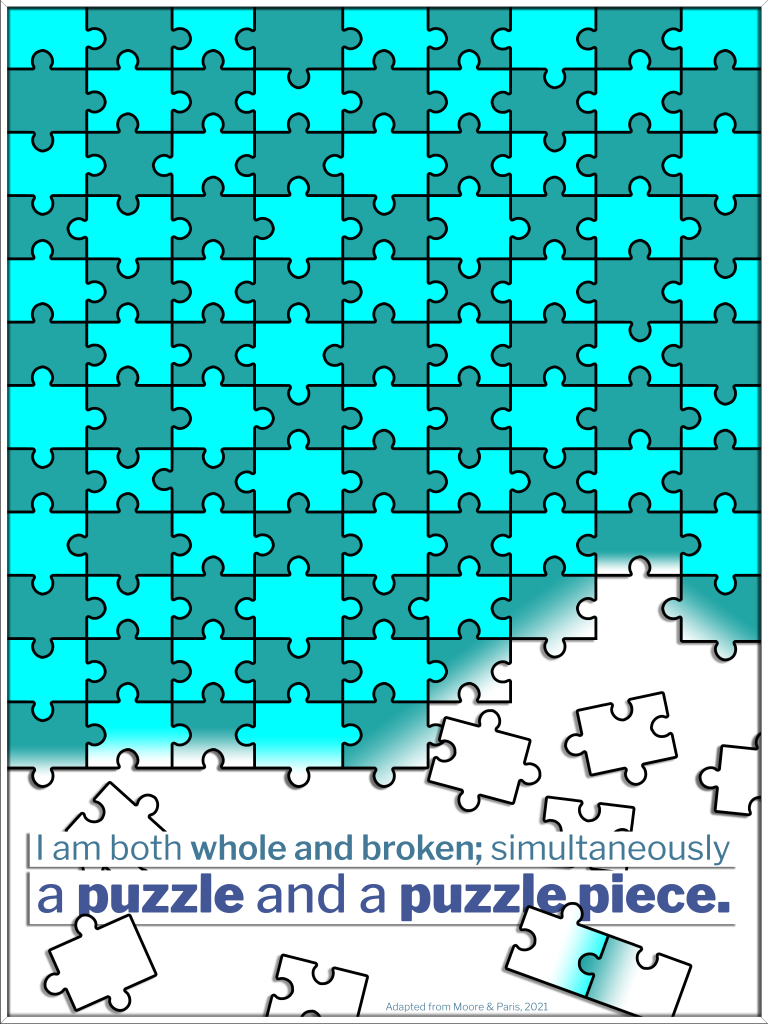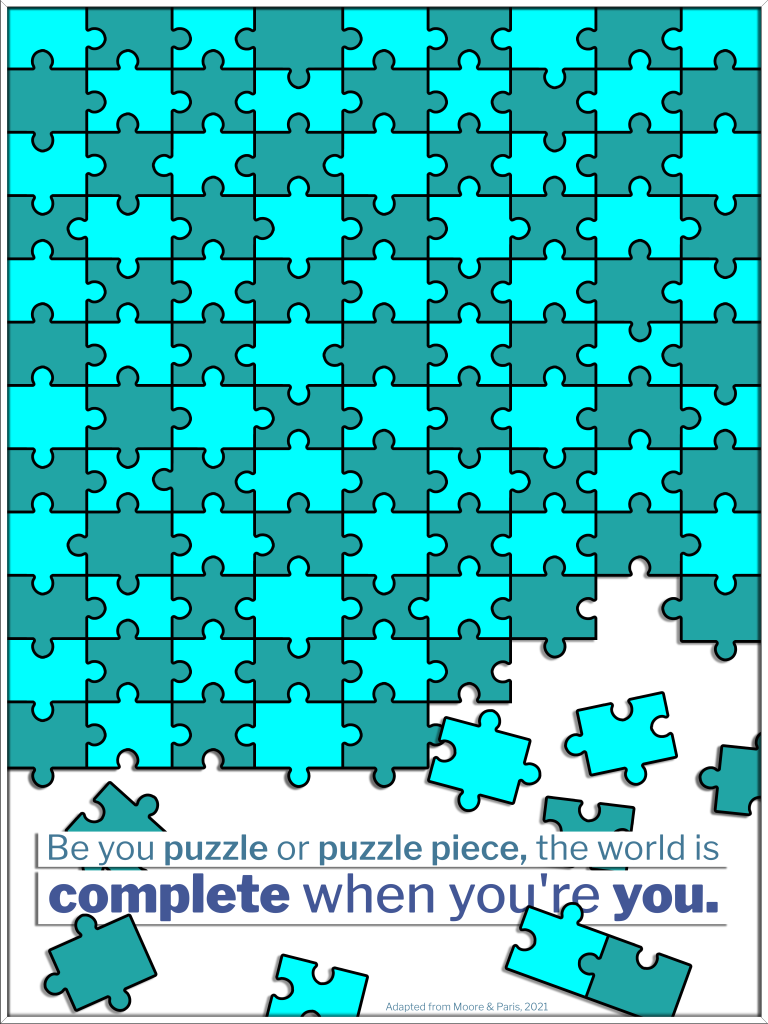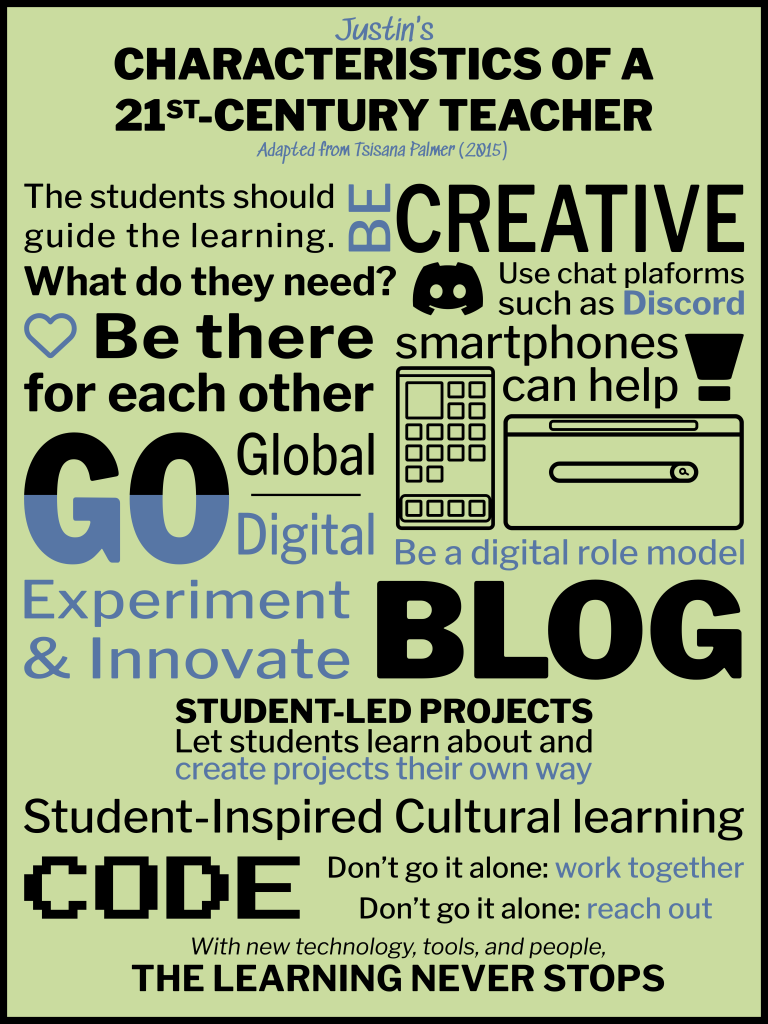Reflection Posters

Puzzle Lenticular Poster First Angle

Puzzle Lenticular Poster Alternate Angle
Lenticular Puzzle Poster Animation

Characteristics Poster
Aside from November 11’s class-wide and small group discussions, it has not often talked about among my peers, but something we all agree on is that the posters on the walls of our elementary and high school classrooms are both old and severely lacking in what we want out of classroom posters: representation. We want posters that reflect who we are, the things we go through, and the things we want to achieve. That is why I have created two posters to help aid in that desire.
The first is a lenticular poster of a puzzle placed in a frame, incomplete with scattered pieces surrounding a slightly modified quote from Jazmen Moore and Django Paris’s Singing Counterstories to Imagine an Otherwise: The authors highlight youth spoken word poetry in the context of the global pandemic and the uprisings for racial justice (2021). Their article details the power behind counterstory spoken word poems and chosen spaces as a way for youth to share their family stories, their culture, and to fight back against the injustices of society, against the discrimination in the media and school systems. They give an important message that no one should have to leave a part of themselves at the door, that everyone should feel like they belong, just as they are. They open their article by talking about a young girl named Gloria who performed a poem in English and Spanish talking about the origin of her name, the fact that she is Mexican-American, her family stories, and her understanding of herself. But Gloria also says something that will forever stick with me: Gloria says that “she is both whole and broken; simultaneously a puzzle and a puzzle piece” (Moore & Paris, 2021). What does that say about our society? Here we have a child saying they feel broken. No one should ever feel that way. We need to show students (and anyone else), that the way they are, everything about them, makes them special and that the world is only complete when they are themselves. This is why I did a lenticular poster, we need to teach the idea of looking at things from another angle, not just the school system, but about ourselves as well. It is not about minimizing feelings, it is about rethinking how we understand ourselves.
The alternate angle of my poster does not just contain a written response, you might have also noticed that all of the puzzle pieces are now coloured in. The original seeks to show the alienation one feels when they do not belong; standalone pieces are completely colourless, pieces that are partially connected are partially coloured, and the pieces that are fully connected, have their whole piece coloured in. This second angle shows that you don’t have to “fit in” to be whole. You belong no matter what.
My second poster adapts Tsisana Palmer’s “15 Characteristics of a 21st-Century Teacher” (2015). I did not copy the article one-for-one, as I personally felt the article needed to be updated, not just for 2024, but also because I felt a few things were missing or could be re-worded. Palmer’s original list is still a fantastic resource, this is just my spin on it. Now to break down my changes:
For starters, instead of Palmer’s 15 characteristics, I have listed 16 or 17 characteristics; two of which are very closely related, but could be read differently, so we shall say 16.5 characteristics. That 1.5 is changing “Learner-centered classroom and personalized instruction” to “The student should guide the learning” and “What do they need?”.
Numbers 2, 5, and 11 were simplified to “Be creative,” “Smartphones can help,” and “Be a digital role model.”
Number 4, “Go global”; number 6, “Blog”; number 7, “Go digital”; and number 13, “Code” were kept the same, though 4 and 7 were combined in the same section.
Numbers 8 and 10, “Collaborate” and “Connect,” respectively, were placed together as “Don’t go it alone: work together” and “Don’t go it alone: reach out.”
Numbers 11 and 14 we expanded to “Student-led projects, let them learn about and create projects their own way,” and “Experiment & Innovate.”
I changed “9. Use Twitter chats” to “Use chat platforms such as Discord.” Twitter/X “chats” are public by default, and even if you set your account to private or use DMs, you are very limited in what you can do (since the transition to X, only the original poster can see who liked their tweets/posts). By using a chat service like Discord, students can post photos, videos, links, can chat one-on-one or in groups, just like on X/Twitter; however, they can also create servers, assign roles in those servers (good for project organization), and most importantly, it is much more private, you need a link to join and then you get set it so people need to be approved before joining.
Numbers 3 and 15 are very similar: learn new technologies and learn new tools and technology; so why not merge those into one point? As such, I swapped out point 3 for the surprisingly missing, “Be there for your students,” and changed 15 to be “With new technology, tools, and people, the learning never stops.” Even if the point of the article was based around our new technological world, this should always be a characteristic of a teacher, 21st-century or not.
Lastly, I added an additional point: “Student-inspired cultural learning.” Once again, no student should leave a part of themselves at the door, and so our education systems needs to reflect that ideology. Everyone is welcome, just as they are, and we should be teaching with that in mind. We need to expand our lessons to include culturally inclusive works and projects.
For this project, I have created two posters. The first, the puzzle poster, takes a more illustrative approach; the second, while it includes illustrations, uses a more typographic approach to list characteristics of a 21-st century teacher. My inspiration for the designs mostly came from the content I wanted to represent. As Mary Kalantzis and Bill Cope talk about in their video “11.1 The Contemporary Significance of Visual Meanings” (Education at Illinois, 2016), there is a connection that is made with visual meanings and our ability to understand. By using Gloria’s quote with a incomplete puzzle—both in structure and colour—I hope to convey that feeling of not belonging. For my characteristics poster, there is a lot going on, it will take awhile to full grasp the content, just like the struggle of trying to become a better teacher; but it uses text in a fun way to appeal to that older audience with the occasional illustration to assist in understanding (smartphones are a lively debate for example, so I showed one way of using phones in the classroom). That is not to say both groups cannot use either poster. For the puzzle, teachers also need to be reminded that they belong and the list of characteristics reminds students what their teacher should be doing.
Also my characteristics poster was not inspired by it, but I realized after completing it that in both my elementary school and high school we had this this blue and purple poster that was in basically every room that had mostly words on it (it listed different Catholic virtues and the like). It was very busy with the text overlaid on top of a faded image or two in the background making it hard to read. So, there is another reason for text-heavy posters to have minimal image coverage.
References
Education at Illinois. (2016, April 19). 11.1 The contemporary significance of visual meanings [Video]. YouTube. https://www.youtube.com/watch?v=ozlu2l9V-oM
Moore, J., & Paris, D. (2021). Singing counterstories to imagine an otherwise: The authors highlight youth spoken word poetry in the context of the global pandemic and the uprisings for racial justice. English Journal, 110(4), 21+. https://link-gale-com.proxy1.lib.trentu.ca/apps/doc/A750373283/AONE?u=ocul_thomas&sid=bookmark-AONE&xid=b6337577
Palmer, T. (2015, June 20). 15 characteristics of a 21st-century teacher. Edutopia. https://www.edutopia.org/discussion/15-characteristics-21st-century-teacher
